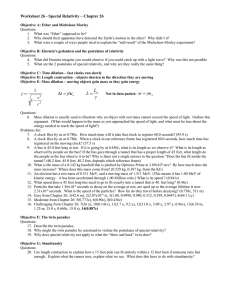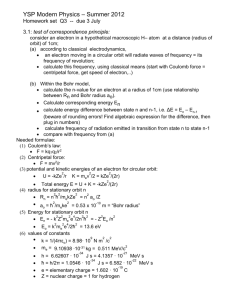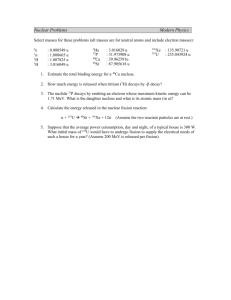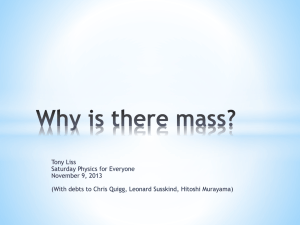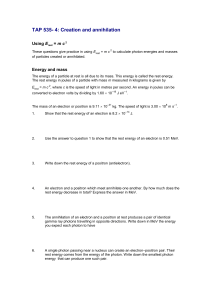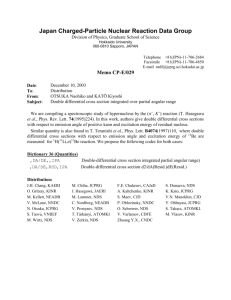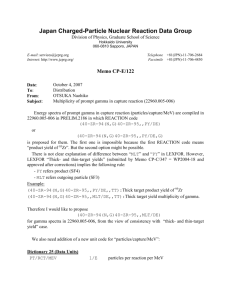Fundamental Concepts end & nuclear enegetics - radiochem
advertisement
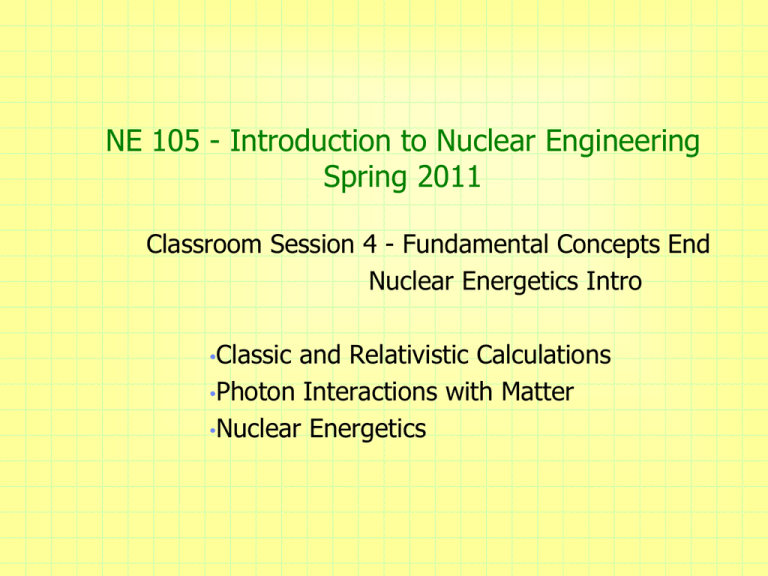
NE 105 - Introduction to Nuclear Engineering Spring 2011 Classroom Session 4 - Fundamental Concepts End Nuclear Energetics Intro •Classic and Relativistic Calculations •Photon Interactions with Matter •Nuclear Energetics Electron Volt Work done by one electron accelerated through a potential difference of one volt 1 eV = 1.60217646x10-19 J Example: What is the speed (m/s) of a 12 eV (from the chart of the nuclides: 134Xe 134Xe ion? Weights = 133.905394 AMU) Use classic concept of KE for now amu in table 1.5 Joule = Energy, Work = Force (N) x d =kg m2/s2 2 Correction of the book… REMEMBER! Book: Page 6 Please ignore the c2. It is confusing 3 4156.4 m/s ~9,300 m.p.h i.e. even very low energy ions are moving pretty fast Please remember this is ONLY for classical calculations. At energies close to “c”, need to use relativistic calculations 4 What is the speed of a 100.00 MeV proton: m /s /s 8 3e 0 84 13 e8 38 1. m m /s g/ s 7 46 5, 5. m /s 4. 54 0 3. 20% 20% 20% 20% 20% 2, 2. 102,540 m/s 5,467 g/s 1.38e8 m/s 13840 m/s 3e8 m/s 10 1. 5 What is the speed of a 100.00 MeV proton: 100MeV proton = 0.46 c :close to the speed of light. i.e. classic equations do NOT hold i.e. 0.46 is likely wrong 6 Newton Laws For over 200 years, Newton’s laws worked Accurately described many physical behaviors Unifying the earth and the skies Previously: Sub-lunar sphere: impure and imperfect Skies: perfect and immutable (circle, ether) 7 Special Theory of Relativity - Effects “Mass Increase” with increasing velocity m(v) m0 2 1 v c 2 Increase quantified by Lorentz factor (): 1 always 1 v c 2 2 v<<<c 1 classic limit v~c 0 effect is max 8 Special Theory of Relativity - Effects Length and time are also modified relative to an object’s speed L(v) L0 1 v c 2 t (v) 2 t0 1 v c 2 2 For example: To find speed… 9 Special Theory of Relativity - Effects E mc m0c KE 2 2 What is the kinetic energy of a 100.00 MeV proton? Hint: Relativistic speeds, i.e. use this equation: m(v) m0 2 1 v c 2 10 Reminder: simple error is Accepted Value - Obtained Value 100 % Error Accepted Value The error grows as v c 11 Remember Relativistic calculation required when: kinetic energy ~ rest energy What is the rest mass of an electron? What is the rest mass of a p+ or n0? What is the rest mass of heavy ions? (Table 1.5 book) Use: eV keV MeV 12 What is the kinetic energy of a 1 MeV electron? Rest mass of the electron, me=0.511MeV 20% 20% 20% 20% 20% M eV 0 M eV 1 M eV 0. 99 9 M eV 9 48 0. 5. M eV 4. 1 3. 51 2. 0.511 MeV 0.489 MeV 0.999 MeV 1 MeV 0 MeV 0. 1. 13 What is the speed of a 1 MeV electron? Rest mass of the electron, me=0.511MeV 20% 0. 99 3c 5. 20% 0. 94 c 4. 20% 0. 86 c 3. 20% 0. 81 c 2. 0.58c 0.81c 0.86c 0.94c 0.993c 0. 58 c 1. 20% 14 Solution: mc 2 m0c 2 KE 0.511MeV 1MeV 1.511MeV 2 and solving for v, from relativistic equation mc = m0 c2 : 2 0.511 v 1 c 0.94 c 1.511 15 Special Theory of Relativity - Effects In Nuclear Engineering we rarely work with neutrons of more than 10MeV. We stick to classic calculations for KE of p, n, , ions, and fission fragments Homework 2.3. What is the error in computing speed of a 10 MeV neutron classically instead of relativistically? 16 Radiation Interaction with Matter Ionizing Radiation Photon Interactions Energy Low Photoelectric Effect Intermediate Compton Scattering High Pair Production 19 Pair Production 20 Compton Scattering 21 The Photoelectric Effect 22 Compton Scattering – The Experiment In 1922, Compton obtained this data Scattered X-Rays had an increase in wavelength Can you explain why? E’ E 23 Compton Scattering – Light has p! E’ E Why the equation written for the photon angle? h ' (1 cos s ) me c 1 1 1 (1 cos s ) E ' E me c If light is a wave, then radiation scattered by an electron should have no change in wavelength In 1922, Compton demonstrated that that x-rays scattered from electrons had a decrease in wavelength. This is only possible if light is treated as a particle with linear momentum equal to p=h/ 24 Follow equations But pay attention to units For wavelength please use nm 1 kg m 2 1e9 nm h 6.63e-34 J . s [] nm 2 me c 9.11e-31 kg 3e8 m / s 1 J . s 1m 25




